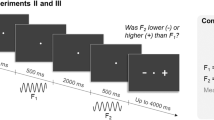Abstract
Inflexible behavior is a core characteristic of autism spectrum disorder (ASD), but its underlying cause is unknown. Using a perceptual learning protocol, we observed initially efficient learning in ASD that was followed by anomalously poor learning when the location of the target was changed (over-specificity). Reducing stimulus repetition eliminated over-specificity. Our results indicate that inflexible behavior may be evident ubiquitously in ASD, even in sensory learning, but can be circumvented by specifically designed stimulation protocols.
This is a preview of subscription content, access via your institution
Access options
Subscribe to this journal
Receive 12 print issues and online access
$209.00 per year
only $17.42 per issue
Buy this article
- Purchase on Springer Link
- Instant access to full article PDF
Prices may be subject to local taxes which are calculated during checkout



Similar content being viewed by others
References
Sumiyoshi, C. et al. Neurosci. Res. 69, 252–257 (2011).
Dawson, M., Mottron, L. & Gernsbacher, M.A. in Learning and Memory: a Comprehensive Reference (eds. Byrne, J. & Roediger, H.L.I.) 759–772 (Elsevier, Oxford, 2008).
Sagi, D. Vision Res. 51, 1552–1566 (2011).
Harris, H., Gliksberg, M. & Sagi, D. Curr. Biol. 22, 1813–1817 (2012).
Karni, A. & Sagi, D. Proc. Natl. Acad. Sci. USA 88, 4966–4970 (1991).
Ahissar, M. & Hochstein, S. Nature 387, 401–406 (1997).
Greenlee, M.W. & Magnussen, S. Vision Res. 28, 1303–1310 (1988).
Brown, J., Aczel, B., Jiménez, L., Kaufman, S.B. & Grant, K.P. Q. J. Exp. Psychol. (Hove) 63, 1789–1812 (2010).
Roser, M.E., Aslin, R.N., McKenzie, R., Zahra, D. & Fiser, J. Neuropsychology 29, 163–172 (2015).
Petrov, A.A., Van Horn, N.M. & Ratcliff, R. Psychon. Bull. Rev. 18, 490–497 (2011).
Liu, C.C. & Watanabe, T. Vision Res. 61, 107–114 (2012).
Qian, N. & Lipkin, R.M.A. Front. Hum. Neurosci. 5, 77 (2011).
Webster, M.A. J. Vis. 11, 3 (2011).
Harris, H. & Sagi, D. Vision Res. 109, 77–86 (2015).
Lord, C. et al. J. Autism Dev. Disord. 30, 205–223 (2000).
Lord, C. et al. J. Autism Dev. Disord. 24, 659–685 (1994).
Acknowledgements
We thank R. Egan, A. Gupta and J. Geskin for their assistance in data collection, and D. Plaut and R. Malach for fruitful comments and discussions. This work was supported by grants from the US-Israel Binational Science Foundation and the Simons Foundation Autism Research Initiative. H.H. thanks the Azrieli Foundation for the award of an Azrieli Fellowship.
Author information
Authors and Affiliations
Contributions
H.H., M.B. and D.S. designed the experiments. D.I., N.M. and Y.B. handled the clinical aspects. H.H. and M.B. collected the data. H.H., M.B. and D.S. analyzed the data. H.H., D.J.H., M.B. and D.S. wrote the paper.
Corresponding author
Ethics declarations
Competing interests
The authors declare no competing financial interests.
Integrated supplementary information
Supplementary Figure 1 Over-specificity with shorter stimulus durations.
Same format as Fig. 2a. Black curve: a group of ASD observers (n = 3) were trained with the standard training protocol, but with shorter stimulus presentation time of 10 ms (instead of 40 ms, used in Fig. 2). Gray curve: data from a group of non-matched control observers (see Methods, n = 24). Learning at location 1 of the ASD group matches the learning of the typical group. A one-way repeated measures ANOVA uncovered a significant effect of day (F(4,8) = 5.04, p = 0.02). Subsequent two-tailed pairwise comparison found significant learning following training (from day 1 to day 4, p = 0.015). Numerically, the initial performance level at the new location (day 5; 133 ± 16 ms) was worse than the trained performance level (day 4; 91 ± 18 ms), implying specificity of learning. However, the difference was not significant (p = 0.1). Also, the initial performance at the new location (day 5) was not significantly different from the initial performance level (day 1, p = 0.09), supporting specificity of learning. Typically, there are no performance relapses at location 2 (days 5-8, ‘standard’ group), but the ASD group showed a drop in performance on day 7 (125 ±11 ms) relative to day 6 (93 ± 4 ms), which was followed by a significant improvement on day 8 (p = 0.03). Notably, while in Fig. 2 there is ~30ms difference between the ASD and control groups’ initial performance level, here the initial thresholds of the ASD and non-ASD groups are closer. This implies that the stronger target duration time applied in Fig. 2 increased the difference between ASD and controls and may be explained by an increased sensitivity of the ASD observers to stimulus intensity.
Supplementary information
Supplementary Text and Figures
Supplementary Figure 1 (PDF 224 kb)
Rights and permissions
About this article
Cite this article
Harris, H., Israeli, D., Minshew, N. et al. Perceptual learning in autism: over-specificity and possible remedies. Nat Neurosci 18, 1574–1576 (2015). https://doi.org/10.1038/nn.4129
Received:
Accepted:
Published:
Issue Date:
DOI: https://doi.org/10.1038/nn.4129
This article is cited by
-
Altered responses to social chemosignals in autism spectrum disorder
Nature Neuroscience (2018)
-
Visual learning with reduced adaptation is eccentricity-specific
Scientific Reports (2018)
-
Motivational wheel running reverses cueing behavioural inflexibility in rodents
Journal of Neural Transmission (2017)



